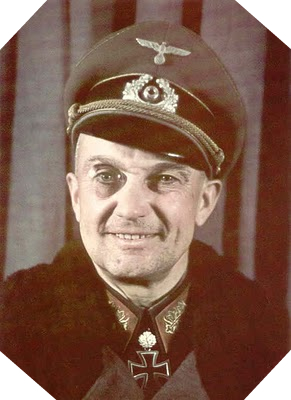Walter Model
Biography
Walter Model was born on January 24, 1891 in Genthin. He joined the army in 1908 and joined the 52nd Infantry Regiment as a lieutenant in 1910. When World War I broke out, his unit took part in the fighting on the Western Front, and in May 1915 Model was seriously wounded near Arras. In October of the same year he is awarded the Iron Cross. Promoted captain in November 1917, he ended the war in the 36th reserve division.
Highly noted and supported by many of his superiors, he remained with the Reichswehr after 1918, along with 4,000 other officers. In 1925, he was transferred to the 3rd Infantry Division, considered one of the best German units of the time. He is interested in the possibilities of modernization of the army as well as in general tactics and at the same time he is getting closer to the National Socialist Party cadres.
At the beginning of the Second World War, Walter Model was Chief of Staff of the 4th Corps during the invasion of Poland and the 16th Army during the French Campaign. During this period, he focuses on developing new tactics by emphasizing Combat Combat. On June 22, 1941, he participated in the invasion of the Soviet Union as part of Operation Barbarossa. Model stands out for the speed of the progression of his unit. In January 1942, while the Soviets took the initiative, he was placed at the head of the 9th Army and took charge of the northern part of the Kursk assault on 5 July 1943 as part of Operation Citadel. This offensive is a failure and precipitates a little more the German retreat. On January 29, 1944, Model is sent to Estonia where he must stop the Soviet advance but the situation is desperate for the Germans who continue their general retreat.
On March 1, 1944, he was the youngest Wehrmacht officer to be promoted Feldmarschall. A month later he replaced General Manstein at the head of the Northern Ukraine Army Group, before being urgently called to support the Central Army Group while the Soviets liberated the city of Minsk. On August 17, 1944, Model is transferred to the western front in Normandy where the situation of the German forces is also desperate at this time. He takes the place of General von Kluge, held responsible for the failure of Operation Lüttich in Mortain and who commits suicide on 18 August. His Army Group B is encircled in the Falaise pocket and he orders his units to retreat east of the Seine, then east of the Rhine a few days later.
In September 1944, the Allies launch Operation Market Garden while Model reorganizes and re-equips Army Group B. With its heavy means, it attacks airborne light units that retreat and cancels the hope that Allied the Allies to put an end to the war before Christmas.
His new strategy is to bleed enemy armies as much as possible before they arrive on the Siegfried line, because he believes the German forces are no longer able to counter-attack massively and regain the advantage. It inflicts the 1st US Army the loss of 33,000 soldiers during the battle of the forest of Hürtgen.
The conduct of the counter-attack desired by the Führer at the end of 1944 was entrusted to Marshal Model, who then had the last German operational forces. On December 16, 1944, the offensive was launched in the Ardennes but hit hard the American resistance of the 101st Airborne Division in Bastogne. On January 8, 1945, the operation is definitely stopped.
Hitler then ordered Model’s troops to stay on the ground and defend their positions until death as the Americans cross the Rhine at Remagen. On April 1, 1945, Army Group B was encircled by the 1st and 9th American Armies and Walter Model, against the order of his Führer, decided to retreat his men. He dissolves his unit, leaving the choice to his soldiers to go or fight their way through the enemy lines.
Refusing to surrender personally, he prefers to end his life on 21 April 1945 by shooting himself in the woods near Ratingen. Buried on the spot, it was not until 1955 that his son, with the help of the officers who served under his orders, found the site of his grave and had his body transferred to the Vossenack military cemetery near the Hürtgen forest.

